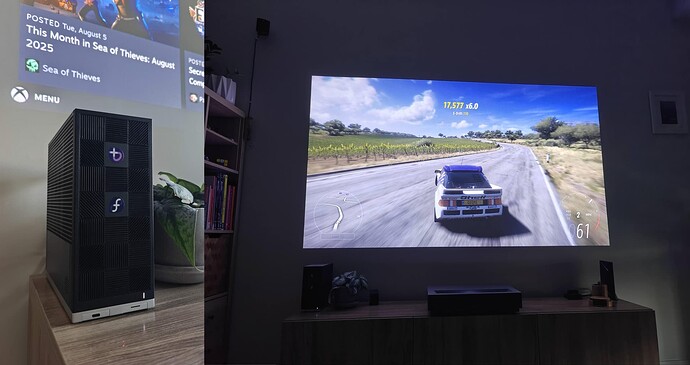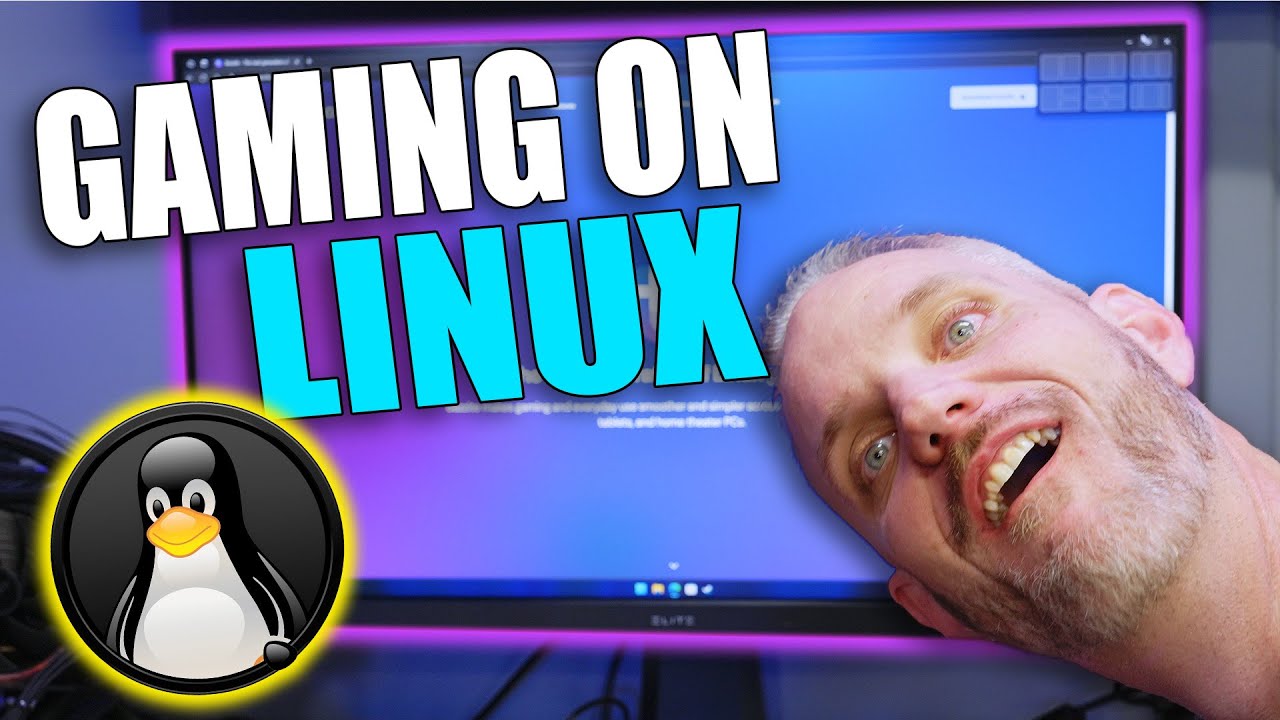Hello everyone. Did you enjoy your summer holidays? I certainly did. As are coming to an end, in we will share with you some of the changes that happened during the summer. Among them, support arrives for the Ayaneo 3, AOKZOE A1X. Bazaar gets a major performance update. Then, Bazzite gets a major boot speed boost, and general performance that should eliminate any difference seen with other distributions.
New Device Support
Over the last month, we worked hard to enable support for two new powerful devices: the Ayaneo 3, and the AOKZOE A1X.
Ayaneo 3
Ayaneo 3 is a device by Ayaneo with detachable controller modules, a gorgeous HDR OLED screen option, and advanced controller with 4 paddles, and hair trigger locks. We add full support for it, via the kernel and Handheld Daemon, and the support on Bazzite includes popping the modules, RGB, extra button support, charge bypass, fan curves, HDR, and 60/90/120/144 refresh rate options for the OLED screen.
Missing are customizations for the extra modules, due to them being on back-order (they will work as a mouse/xbox controller), but that should improve in the future.
Here is a video of detaching the modules. We also detect which modules are connected at any given time.
Aokzoe A1X
We also add support for the AOKZOE A1X. This is a device with a large beautiful 120hz VRR 8in display, a 73Wh battery, and an AMD HX 370 option. If the Legion Go S had a Pro brother, this would be it. The big screen is welcome, esp. if you have bad eyes (like me), and it packs that inch while having around the size of the Ally X! So great for portability too.
This device is similar to OneXPlayer, so support for it is added via the oxpec driver we upstreamed earlier this year (it’s in 6.16!). We will send its ID to the kernel in the following days as well. We added support for all its RGB modes, fan curves, charge bypass, gyro, and charge limit.
Framework Desktop
The Framework Desktop is finally available and it’s a beaut! This is easily our favorite HTPC option on the market right now, and best of all Bazzite is an officially supported operating system for it.
Framework was kind enough to send us some tiles with the Bazzite logo on them and we’re doing a giveaway, so if you have a Framework Desktop and want a chance to win, make a post of your Framework Desktop in the #showcase channel of our Discord and we’ll pick 10 lucky winners at random.
Other device improvements
This update also introduces preliminary support for the MSI Claw A8. The MSI Claw A8 is MSI’s AMD variant, which released with the new Z2E processor. We also add preliminary support for the Legion Go 2. Both devices have some quirks with setting TDP (some times the values are not set) and we would like to polish the experience more before calling it final.
In addition, all Claws get an update that should improve controller after resume functionality and dual booting with Windows. However, this comes with the caveat that the back buttons will not work by default. To re-enable them, toggle Dinput Mode in controller settings in Handheld Daemon to restore the old functionality.
Then, the Z13 gets a kernel patch that should fix crashes after sleep, and perhaps runtime crashes, allowing us to say Z13 support is no longer in Beta and has full functionality (there are still some spurious wake-ups when the device is docked/attaching the folio). The OLED devices OneXPlayer F1 Pro/EVA-1, Zotac Zone, and Ayaneo 3 get a kernel patch that fixes the screen turning off while adjusting the brightness.
Handheld Daemon improvements
Handheld Daemon gained the ability to work with external controllers over the summer, including the Steam Deck controller. This is in preparation for enabling it globally in the future, so that we can provide the same level of customization we do for other devices to the Steam Deck and HTPCs. It can also be enabled globally now with just sudo systemctl enable –-now hhd. We also fixed a bug with changing tuned power profiles and a spurious message that the update failed when updating. And for handheld users, when using Steam Controller emulation, the gyro and number back buttons match your device configuration now.
From HTPC users, we would like to hear from you in what customizations you would like to see from it, while you are gaming in gamemode or in desktop. Especially from you Asus users. Since Handheld Daemon supports the Z13, we would also love to add support for Asus laptops, so that you get feature parity once the Asus images are dropped (see below).
Performance Improvements
We heard you, you think Bazzite is slow. While it breaks our heart ![]() there might have been some truth to this, so we spent some time optimizing performance, especially in regard to Cyberpunk, where we heard from a lot of you that performance was lacking, and boot speed.
there might have been some truth to this, so we spent some time optimizing performance, especially in regard to Cyberpunk, where we heard from a lot of you that performance was lacking, and boot speed.
Specifically, we found that there was a bug in our boot services where some of them waited until you connected to a network, and for Nvidia users that your flatpaks updated (so that they do not crash due to a driver update). We tweaked the services to remove this requirement, and made our bazzite hardware setup service only run once per changed version. All in all, this reduces boot time to be around 15s (~7s post-grub). This translates to a reduction of 5s for everyone, if your network is slow to connect 10-20s, and if you are an Nvidia user well, whatever you had before minus 15s.
Then, we looked over into the kernel, prompted by this thread. We revisited a lot of the customizations that we were doing before, found a regression in the BORE scheduler (Which has now been fixed upstream), and moved to using a min. linear frequency on handhelds for high TDPs. All in all, most of you should get a nice 5% improvement on Cyberpunk, and some of you might get 10-30% more performance (especially Intel users).
We hope this bridges the performance difference you have seen versus other places. Moving forward we will continue to reassess tweaks that have been applied to our kernel and sysctl configs and work on a robust benchmarking suite to catch edge cases.
Bazaar Update
Bazaar also got a huge refactor over the summer, reducing the background service memory use to only 35mb and polishing up a number of things you’ve reported to us since launch. You can now also find it on Flathub and in a number of distros repositories! Go check it out!
Deprecation Notices
Dropping Asus/Surface Images
We plan to stop building ASUS and Surface images some time after the Fedora 43 release. We will add support for these devices to the main images. After everyone is happy with this support, we will stop building these images and migrate the users to the main images (We’re looking at retagging our images so that a rebase won’t be necessary for existing users). So, we ask for some feedback over the next months so we can make this happen.
To give some context, these images used to come with their own custom kernel and a lot of changes to make sure they work properly. However, since last year, we are building our own kernel that includes these fixes, so currently these images only include a few minor packages for support. For Asus devices, we would like to migrate this support to handheld daemon. And for surface images, to perhaps try to upstream support for their pen to the wacom package or to build a fork of it that is included in all images.
Nvidia Closed-Source Images
Nvidia is planning to drop support for cards before and including the 1000 series (Not including the 1600 series cards) from their main drivers in December. After that, the up-to-date driver we use in closed images will no longer support these cards. Instead, the driver that releases in December is an LTS driver, and will have to be used with them with only security fixes going forward.
This means that we will have to switch the closed source driver image to using the LTS driver. Our plan is to support this for as long as possible, but eventually this will no longer be tenable and these images will disappear. We’ll put out more announcements as this date approaches. If you aren’t already thinking about it now is a great time to upgrade to an AMD GPU.
Into the future
Of course, these are just the highlights (e.g., we also worked with Red Hat to fix the bug JayzTwoCents hit), and a lot more things went on in the background. Over the following months, we are looking forward to the ROG Xbox Ally and the Legion Go 2 releasing.
Here are some articles you might have missed:






